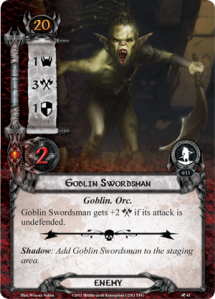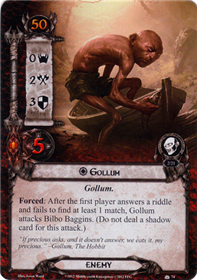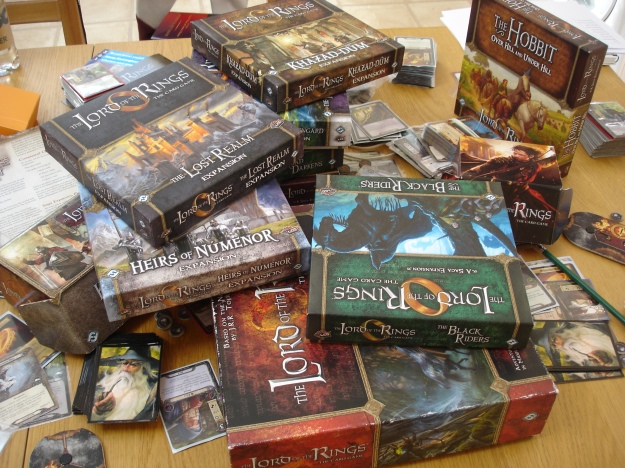When building decks for the Lord of the Rings living card-game, a major question you need to consider, is how many copies of each card to include.
A legal deck for this game needs a minimum of 50 cards. As far as I’m aware there’s no upper limit, which is good if you are as undisciplined in deck-building as I am, and regularly get card-counts into the high 60s. By default, you can have 1-3 copies of a card by a particular title in your deck, although there are some cards which have tighter restrictions.
At the one extreme, that means you could build a legal deck with only 17 different cards if you ran three of each (or two of one of them). On the other hand, you could run 50 or 60 different cards if you wanted single copies only – when I used to play the Game of Thrones LCG, I occasionally encountered people playing this “Highlander” version of the game.
1 of Each
 So far, there are 4 cards which have a “limit 1 per deck” although this looks set to grow in the Angmar Awakened with the rise of player side-quests. The current cards are Black Arrow, Path of Need, Fall of Gil-Galad, and Gather Information.
So far, there are 4 cards which have a “limit 1 per deck” although this looks set to grow in the Angmar Awakened with the rise of player side-quests. The current cards are Black Arrow, Path of Need, Fall of Gil-Galad, and Gather Information.
Black Arrow is a very powerful card. It costs zero and isn’t restricted. As far as I can tell, if you have a Tactics Hero, and there’s going to be a Ranged Hero in play, there’s no reason why you wouldn’t play this. It enables your hero to knock out that one big bad, and even has victory points.
 Path of Need is a little more situational – it’s undoubtedly a powerful effect: heroes don’t need to exhaust to quest, attack, or defend whilst it’s attached to the active location, but the limit 1 per-deck makes it hard to draw consistently, and when you do, it still costs 4 resources to play. Add to that the fact that you’ll probably blaze through in a single round, and it becomes marginal as to whether the pay-off justifies the cost.
Path of Need is a little more situational – it’s undoubtedly a powerful effect: heroes don’t need to exhaust to quest, attack, or defend whilst it’s attached to the active location, but the limit 1 per-deck makes it hard to draw consistently, and when you do, it still costs 4 resources to play. Add to that the fact that you’ll probably blaze through in a single round, and it becomes marginal as to whether the pay-off justifies the cost.
Of course, you can do a certain amount of shenanigans to get repeat use: particularly with cards that swap out the active location (Strider’s Path, West Road Traveller), although the most obvious one – Thror’s Map was errata-ed (for those that care about that sort of thing) to stop you from generating an infinite loop. These days, you can probably get exhaustion-free combat round after round, but not questing.
 The third 1 per-deck card, was the Fall of Gil-Galad. This is a spirit attachment, a song which lets you lower your threat when a hero dies. Now, obviously, threat-reduction is always good, and a sizeable chunk of threat reduction (whatever that hero’s treat-cost was) is particularly handy at the moment of crisis where a Hero has just died – it might give you the breathing-space you need to avoid engaging enemies for a round or so, or to allow you to fail the quest whilst you repel boarders without threating-out.
The third 1 per-deck card, was the Fall of Gil-Galad. This is a spirit attachment, a song which lets you lower your threat when a hero dies. Now, obviously, threat-reduction is always good, and a sizeable chunk of threat reduction (whatever that hero’s treat-cost was) is particularly handy at the moment of crisis where a Hero has just died – it might give you the breathing-space you need to avoid engaging enemies for a round or so, or to allow you to fail the quest whilst you repel boarders without threating-out.
That said, the card still doesn’t feel that much fun. Unless you have Fortune or Fate, you’re still down a hero. Unless you’re REALLY near the end, you’re probably quite likely to die (as you wouldn’t have lost that hero if you were otherwise in complete control). The fact that it’s an attachment, not an event, means that you have to plan for the hero to die, but the card is explicit that they need to be destroyed, you can’t combo this with Boromir’s discard ability, or Caldara’s or the Great Bridge of Khazad-Dum – although you can use Landroval instead of Fortune or Fate. Ultimately, there are probably better ways of lowering your threat which don’t involve dicing with death so much. If you’re going into the quest planning to have a hero killed, chances are you’re doing something wrong.
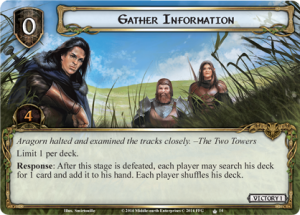 The fourth, and most recent 1 per-deck card was “Gather Information” the first of a new card-type, the Player Side-Quest. When you draw this card, you can add it to the staging area as an additional quest card, meaning that on a chosen round you can place progress on that quest instead of the main quest, and when you have fully explored the stage, you can trigger the relevant response – essentially, it slows you down by a round or so, but gives you a reward- in this case, each player being able to search their deck for a card and add it to your hand.
The fourth, and most recent 1 per-deck card was “Gather Information” the first of a new card-type, the Player Side-Quest. When you draw this card, you can add it to the staging area as an additional quest card, meaning that on a chosen round you can place progress on that quest instead of the main quest, and when you have fully explored the stage, you can trigger the relevant response – essentially, it slows you down by a round or so, but gives you a reward- in this case, each player being able to search their deck for a card and add it to your hand.
Obviously, there are some quests, where this is going to be a terrible card to play (go on, I dare you to use it in Battle of Five Armies) and you’ll certainly need to think twice about wheeling it out in quests with punishing time-effects, but used right, this feels really powerful –the ability to fetch a missing combo piece, or even the card that’s most frustratingly absent right now. This card has only been out a few weeks, but it’s already seen a fair bit of action. I’ll be interested to see whether I’m still using it in 6 months’ time. (This may depend on how good the other side-quests we get are).
How many?
Aside from the exceptions above, for every other card, you’re able to choose how many you run, between one and three. It’s determined by card name, so where there are multiple versions of a character, the limit spans all of them (so you can run Spirit Bofur AND Tactics Bofur in the same deck, but a maximum of three copies between them).
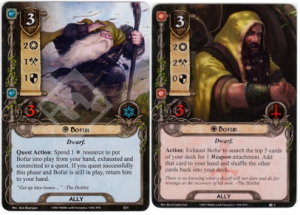
Reasons to be Three-ful
Running 3 of a card gives you a better chance of drawing it than if you only have 1 or 2. If you take your opening hand of 6 cards, there’s a 6 in 50 chance of drawing any given card. If there’s only 1 card there, that’s about a 0.12 chance (roughly ten per cent). With three copies, it goes up to about a third. If you mulligan, there’s now about a 60% chance of having that key card by turn-1 set-up
So, “3 of” looks like a good strategy for making sure you get that key card early on. If your Spirit Glorfindel secrecy deck needs Light of Valinor, just run 3 of, desperate for Asfaloth to go on top and deal with those pesky locations? – 3 of.
Simple, right?
This Hand Ain’t Big Enough For the Both of Us
Well, not quite. There are some cards where having three copies is great. If I have 3 copies of test of will in my hand, I can cancel that definitely-annoying-but-possibly-not-fatal treachery when it comes off the encounter deck. If I have three wardens of healing, then I can heal three times as much damage. In some of the newer quests, particularly archery-heavy ones, that’s a definite boon.
 The trouble is, most decks rely on more than one or two cards. However much your Aragorn hyper-quest deck needs Sword that Was Broken, Visionary Leadership and Faramir out, it’s not going to do a lot if you can’t find those cheap allies to flood the table with. You might think you have a brilliant starting hand when you draw the three key cards in set-up, but if from turns 1-9, all you draw are duplicates of those unique cards, you’re going to be pretty sick. Obviously, that’s an extreme example, but you get the idea: the first copy of a unique card is great, the second or third, with a few exceptions are a pain.
The trouble is, most decks rely on more than one or two cards. However much your Aragorn hyper-quest deck needs Sword that Was Broken, Visionary Leadership and Faramir out, it’s not going to do a lot if you can’t find those cheap allies to flood the table with. You might think you have a brilliant starting hand when you draw the three key cards in set-up, but if from turns 1-9, all you draw are duplicates of those unique cards, you’re going to be pretty sick. Obviously, that’s an extreme example, but you get the idea: the first copy of a unique card is great, the second or third, with a few exceptions are a pain.
Making use of it
There are cards in the game which at least allow you to do something useful with those unwanted duplicates of unique cards. The first of these is everyone’s favourite Shieldmaiden, Eowyn: with her 4 willpower, Eowyn has always been a questing powerhouse, and you have the option to boost that total even higher by discarding cards. In our games, the biggest difficulty is finding a card that someone’s prepared to ditch, but when it’s a dead-card because it’s already in play, that suddenly becomes a better proposition. Add to that the fact that Eowyn can now borrow her uncle’s sword to put that mighty will into attacking as well, and that dead card suddenly doesn’t look so bad.
Whilst it relies on finding and drawing the card, Eowyn’s ability is writ large in Protector of Lorien. This lore attachment, again dating from the days of the core set, allows you to ditch multiple cards to boost willpower or defence. These days, it’s technically limit 3 per phase, although my copies are old enough to let you ditch your whole hand if you like. Being in Lore, Protector is best paired with some powerful card-draw effects which, of course, just make it more likely that you’ll have those duplicates cropping up.
There are some other, slightly less common options for cycling through those duplicate cards:
 Erestor. He’s a unique Noldor ally in Leadership who allows you to discard a card from your hand to draw a card. Erestor’s ability is nice, in that it doesn’t require him to exhaust, so he can be questing for 2 per round whilst you’re triggering his ability, or he can defend in an emergency (only 1 defence, but 3 hit-points)
Erestor. He’s a unique Noldor ally in Leadership who allows you to discard a card from your hand to draw a card. Erestor’s ability is nice, in that it doesn’t require him to exhaust, so he can be questing for 2 per round whilst you’re triggering his ability, or he can defend in an emergency (only 1 defence, but 3 hit-points)
(Hero Erestor was spoiled between when I wrote this article and when I uploaded it. Whilst his function is similar, I’m not going to discuss him here, as I’ve not really had chance to figure him our properly).
Daeron’s Runes functions along similar lines: draw 2 cards, then discard 1 (1 from your hand, doesn’t have to be one of the two you just picked up).
 Watcher of the Bruinen and the Trollshaw Scout are relatively cheap non-unique allies in Tactics, who do a moderate amount of attacking or defending, with the drawback that, after an attack resolves, you have to discard a card or discard the ally from play.
Watcher of the Bruinen and the Trollshaw Scout are relatively cheap non-unique allies in Tactics, who do a moderate amount of attacking or defending, with the drawback that, after an attack resolves, you have to discard a card or discard the ally from play.
Overall then, there are plenty of ways to make lemonade from the duplicate lemons that get stuck in your hand (although only Eowyn’s ability is hero-based and therefore guaranteed to start in play), but this only goes some way to overcome the irritation of drawing a duplicate of a unique card already in play – sure, you can turn it in to +1 Willpower, but you could have done that with a non-unique ally, AND you would have had the option to play that ally as another quester/fighter etc.
There can be only one
So, at the other end of the spectrum, why not run a Highlander deck: single copies of every card?
Well, for one thing, such a deck is wildly inconsistent. Sometimes it might give you exactly what you need, but at other times, it’s going to throw out something completely different. Most decks will have some kind of theme, whether that’s as blatant and explicit as the Outlands Deck (get lots of outlands allies, play them) or the dwarf-swarm (get 5 or more dwarves in play) or something more subtle – if you’re only playing single copies of each card, chances are you’ll struggle to find enough different cards which all fit that theme. There are only a limited number of allies with the required traits or spheres, only a limited number of events which will produce the type of effect you’re aiming for.
 Also, it’s worth noting that with NON-unique cards, the argument against playing 3 is a lot less convincing. A lot of the time, having multiple copies of the same non-unique ally is good, as they do the same thing, but more of it. That said, you do still need to pay for them: 3 Northern Trackers in a deck with only 1 Spirit Hero isn’t necessarily a terrible idea (it is still a REALLY good ally for a lot of quests) but you need to bear in mind that without resource acceleration, it’d take you 12 rounds just to play those three cards.
Also, it’s worth noting that with NON-unique cards, the argument against playing 3 is a lot less convincing. A lot of the time, having multiple copies of the same non-unique ally is good, as they do the same thing, but more of it. That said, you do still need to pay for them: 3 Northern Trackers in a deck with only 1 Spirit Hero isn’t necessarily a terrible idea (it is still a REALLY good ally for a lot of quests) but you need to bear in mind that without resource acceleration, it’d take you 12 rounds just to play those three cards.
Meet Halfway
Between the extremes of 1 and 3, obviously, comes 2. If you’re keen enough to see a card that you want more than copy of it floating around, but you don’t want three (maybe it’s unique, maybe it’s just situational, or quite expensive) then 2 seems like the happy medium.
Interestingly, although I’ve not done any statistical analysis, I strongly suspect that “2 of” is the distribution I use least of. If I’m running a card, I generally want 3. After a while, if I find I’m not really using it, chances are I’ll purge it all the way down to 1.
I’ll freely admit, I’m not one of the best deck-builders this game has seen. Large parts of my decks build themselves (leadership = 3x Sneak Attack, 3x Gandalf, 3x Steward of Gondor. Spirit = 3x Test of Will, probably 3x Unexpected Courage. Any deck with Glorfindel in: 3x Light of Valinor, 3x Asfaloth, 3x Elrond’s counsel etc) and perhaps this is a good moment to re-assess how many copies of a given card truly belong in a deck. Assuming you have a decent chunk of the published card-pool, we are well past the point where we need to throw in three copies of everything, just because there aren’t enough cards to make up the numbers.
I’d be interested to know how others approach the question of how many copies of a given card to include in a deck.
 Well apparently not. Hazy recollections aside, once you actually get down to the numbers, standard difficulty Dwarrowdelf quests don’t really look any surgier than the Mirkwood cycle. The highest probability of surge caps out at around 1 in 9, which is the same as the Hunt for Gollum, but without the forced effect from the quest card revealing extra encounter cards, there are 4 quests (out of 9) with no printed surge whatsoever, and others like the Long Dark have only a token nod to surge with one card in a deck of 60 bearing the word.
Well apparently not. Hazy recollections aside, once you actually get down to the numbers, standard difficulty Dwarrowdelf quests don’t really look any surgier than the Mirkwood cycle. The highest probability of surge caps out at around 1 in 9, which is the same as the Hunt for Gollum, but without the forced effect from the quest card revealing extra encounter cards, there are 4 quests (out of 9) with no printed surge whatsoever, and others like the Long Dark have only a token nod to surge with one card in a deck of 60 bearing the word.

